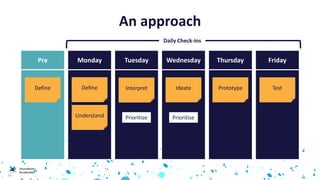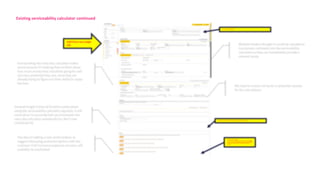Innovations Accelerated - Design Sprint
- 1. Design SprintsEryk Korfel | Jan 2019
- 2. 1. What is your experience with Design Sprints? 2. What do you want to learn? Why are we here?
- 3. W ’ h h m u spend months on this! We have a big problem to solve It should have been solved yesterday Sound familiar? Our typical situation
- 4. A. Have another meeting How might we get ourselves out of this situation? B. Do a business case C. Delegate it D. Run a Design Sprint
- 5. But what is a Design Sprint? The sprint is a five-day process for answering critical business questions through design, prototyping, and testing ideas with customers. The sprint gives teams a shortcut to learning without building and launching. http://www.gv.com/sprint/
- 6. Where it originated • Jake created the Design Sprint approach at Google in 2010 • He ran over 100 sprints with start-ups at Google Ventures from 2012–2017 • Then he wrote the book Sprint about the process. • It combines elements from Agile, Design Thinking and Lean
- 7. Typical outcomes • Align teams and improve collaboration • Get endorsement from the sponsor to progress and deliver a validated idea • Help to convert a prospective client • Build up a product backlog • Cut through politics and elephants • Waste a week
- 8. Types of challenges best suited 3 You don’t have the answer and the team is stuck! 1 You have a big / complex project or problem to solve 2 You’re just starting out 4 It’s going to cost a lot of time or money and you need a solution quick Source: https://www.invisionapp.com/inside-design/popular-design-sprint-questions/
- 9. Types of challenges not well suited 3 If you don’t have leadership buy-in 1 When an effective prototype can’t be produced in a day 2 When it isn’t a product/service design problem 4 When there isn’t enough information up front to effectively inform the solution Source: https://www.invisionapp.com/inside-design/design-sprint-wont-work/ https://designsprintkit.withgoogle.com/planning/initialwork
- 10. Design Sprint 1.0 Source: https://www.invisionapp.com/inside-design/design-sprint-2/
- 11. Design Sprint 1.0 Source: https://www.invisionapp.com/inside-design/design-sprint-2/
- 12. The Methodology Slide image courtesy of Richard Banfield, C. Todd Lombardo, and Trace Wax.
- 13. An approach Slide image courtesy of Richard Banfield, C. Todd Lombardo, and Trace Wax. Understand Interpret Ideate Prioritise Prioritise DefineDefine PrototypePrototype TestTest
- 14. An approach Pre Monday Tuesday Wednesday Thursday Friday Define Understand Interpret Ideate TestPrototypeDefine Daily Check-ins Prioritise Prioritise
- 15. Case Study – Insurance Despite favourable market conditions and a growing home loan book and therefore opportunity, sales of the insurance product have steadily declined, particularly in branches and if left unaddressed, will miss FY plan by ~XX%. Problem • Understand what are the perceptions and behaviours of both our customers and our customer facing employees towards the insurance product • Propose validated concepts on how we can address the declining numbers u ’ u m w b g f u p . Desired Outcomes
- 16. The approach – Week 1 Pre Monday Tuesday Wednesday Thursday Friday Define Understand Interpret Ideate Daily Check-ins Prioritise Prioritise Plan Define
- 17. Monday Tuesday Wednesday Thursday Friday TestPrototype Daily Check-ins Prototype Test Present The approach – Week 2
- 20. Idea 7
- 21. Existing serviceability calculator continued
- 22. Case Study – Insurance • A clearer understanding of the behaviours of the customers and employees • A set of validated concepts with customers and employees, which were prioritised in the respective channel and product backlogs for future refinement and delivery. Outcomes
- 23. Case Study - The British Museum How might we improve wayfinding in the British Museum? Problem They compressed their sprint into two half-days, and conducted a total of 25 interviews with and observations of visitors. Approach The team is looking at piloting the Language Indicators concept over the next year. Outcome https://sprintstories.com/running-design-sprints-in-museums-41a64a8aff50
- 24. Case Study – Happn Generate a broad range of ideas to encourage users to move beyond browsing behaviour and initiate an interaction with other users. Problem Approach Based on this Design Sprint, the Happn team built and released the validated concept, a game, in very close alignment with the prototype. The update was rolled out to and A/B tested by female-identifying users in 3 countries. 46% of users who played the game once played a second time. Overall, engagement for women increased 27% Outcome https://designsprintkit.withgoogle.com/introduction/case-studies/happn-increases-user-engagement
- 25. Story Time!
- 26. Share experiences! – 10min 3 Outcomes? 1 Context and problem? 2 Approach? By the book or adapted - Why? 4 Major learning?
- 27. Still Keen?
- 29. The team • The facilitator (you?) • The product manager/owner (probably the decider) • UX Designer • Delivery/Development manager (they’ll help carry the customer stories forward) • Tech Architect / Engineer • Customer representative • Marketer
- 30. • Write a sprint brief: Sprint Goal, Intended Outputs and Relevant Insights • Get the right sponsor (including for prospective clients) • Prepare a suitable plan / schedule • Assemble Your Design Sprint Team! Lock them in! • Do your pre-research - obtain and synthesize it before the sprint • Schedule all customer interviews and lightning talks ahead of time to keep to the schedule. • Set up the space the team will work in with everything they need and remove distractions As a facilitator, some things you need do… Before During After
- 31. • Stick to the schedule methodology - Stay orgranised but adapt • Delegate - Ask for help if you get overwhelmed • Update the sponsor through daily standups • Document as you go with templates – Content over Form • Keep the momentum and engagement going! • Pace your coffee intake and drink plenty of water As a facilitator, some things you need do… Before During After
- 32. • Summarise outputs and learnings into a proposal pack and pitch it back to the sponsor! • Take the opportunity to leverage momentum by sharing with the wider team • Save and store all artefacts. You don’t need to digitise everything. • Set a plan for what’s next! As a facilitator, some things you need do… Before During After
- 33. Seems simple Enough. Let’s do it!
- 34. Engage others in the community. Y u’ h p fu y m someone new today who you can use as a sounding board or coach to guide you on your next Design Sprint! Get Support Some final hot tips! • AJ & Smart (Youtube Series) • Duco app (Android and Apple) • G g ’ D g Sp K • Google Ventures Sprint website • Sprint Stories • RealTimeBoard • InVision Online resources
- 35. “...many methods start out as legitimate tools to promote better, clearer thinking faster and end up as activities substituted for thinking ... This happens when the method gets watered down and over-hyped in practice. Practitioners start identifying their expertise with the style of activity (e.g. “I run focus groups”) rather than with the substance of the intended outcome and the discipline the method requires.” - Erika Hall “ Source: https://medium.com/mule-design/design-sprints-are-snake-oil-fd6f8e385a27
- 37. ’m h u h experiences with Design Sprints Hi! I’m Eryk You can contact me at eryk@iaccelerated.com




































